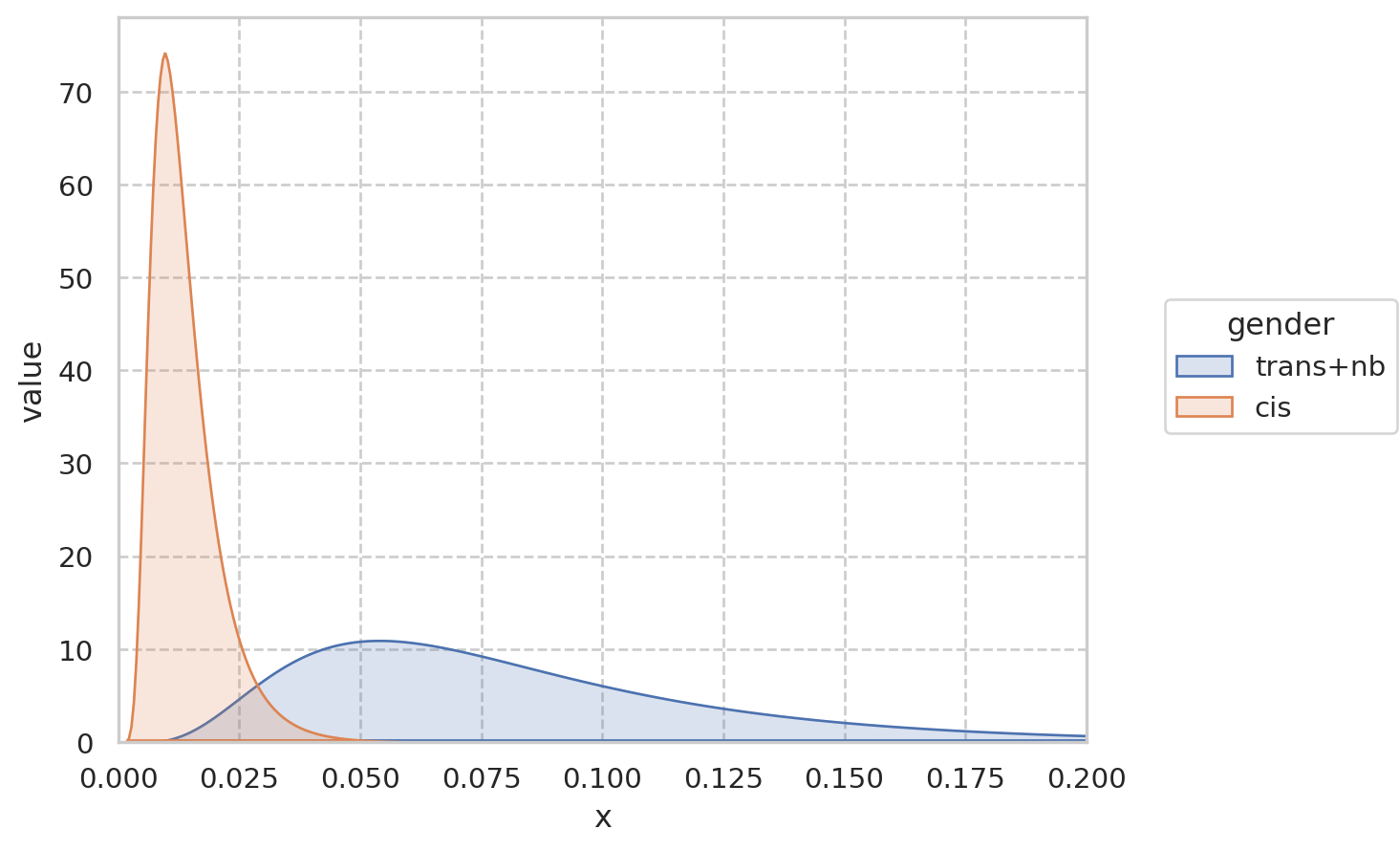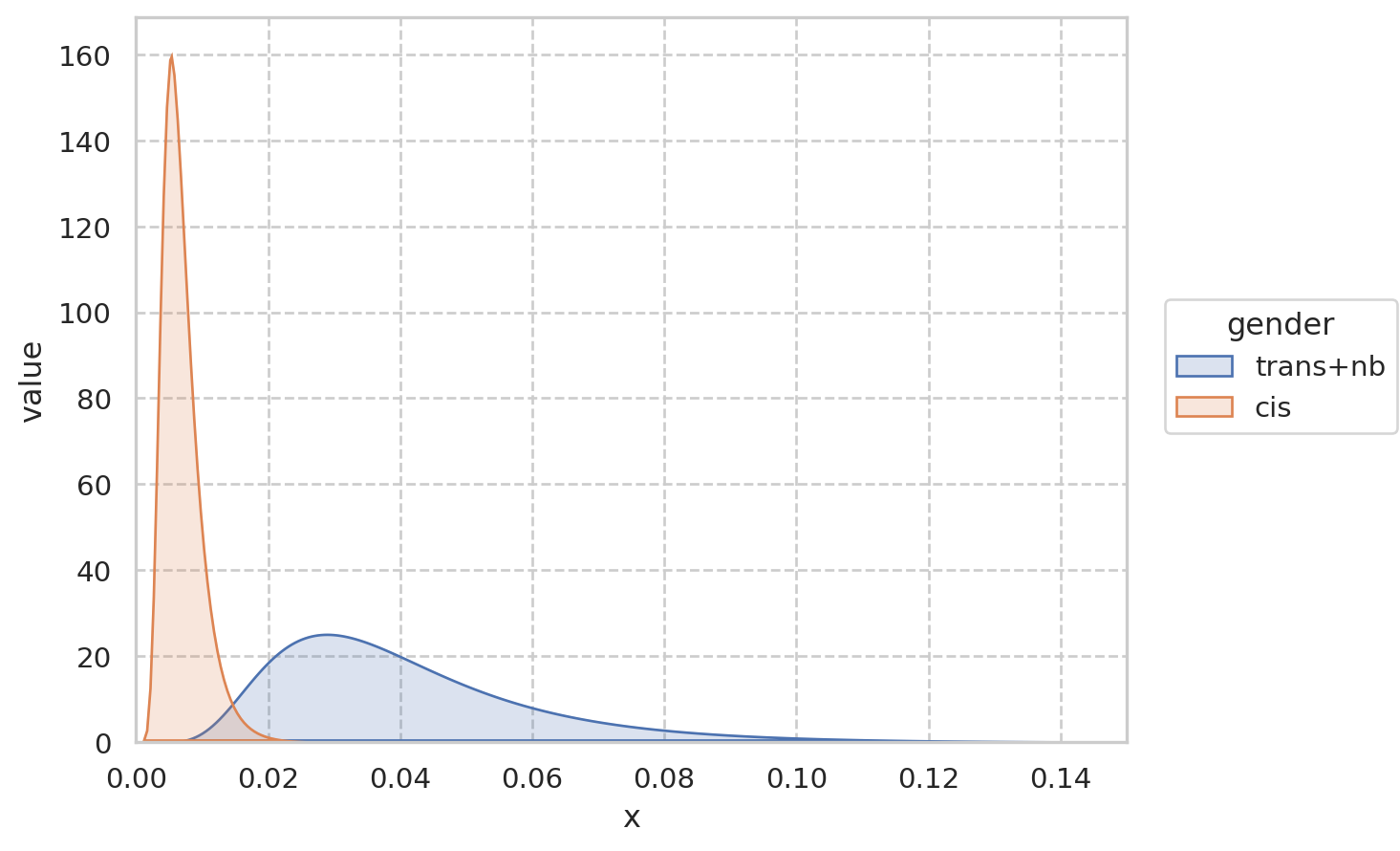Thomas Bayes can tell you if you're Transgender

As some of you may know, I'm autistic. Nothing major, just a few things I do differently on a daily basis, and a few abilities I have others don't and vice-versa.
My therapist sent me this Nature Comms article about gender identity and autism two months ago, and I was mildly annoyed that every quantity was reported as an Odds-Ratio and not just a probability \(p\in (0,1)\).
Some results are harder to parse this way, such as:
Transgender and gender-diverse individuals had higher rates of autism diagnosis compared to cisgender males (OR = 4.21, 95%CI = 3.85–4.60, p value \( < 2 × 10^{−16}\), cisgender females (OR = 6.80, 95%CI = 6.22–7.42, p value\( < 2 × 10^{−16}\), and cisgender individuals altogether (i.e., cisgender males and cisgender females combined) (OR = 5.53, 95%CI = 5.06–6.04, p value\( < 2 × 10^{−16}\)
So how do we translate such a thing as \(\text{OR} = 4.21\) ? Let's find out.
Crunching the numbers
To interpret this statement
Transgender and gender-diverse individuals had higher rates of autism diagnosis compared to cisgender males (OR = 4.21, 95%CI = 3.85–4.60, p value \( < 2 × 10^{−16}\), cisgender females (OR = 6.80, 95%CI = 6.22–7.42, p value\( < 2 × 10^{−16}\), and cisgender individuals altogether (i.e., cisgender males and cisgender females combined) (OR = 5.53, 95%CI = 5.06–6.04, p value\( < 2 × 10^{−16}\)
we should look at the methodology described in the second figure's legend: we should interpret
$$\text{OR} = p/q = \dfrac{\mathbb{P}(\text{Autism}\mid \text{GD}) }{\mathbb{P}(\text{Autism}\mid \lnot\text{GD})} $$
where \(\text{GD}\) corresponds to being gender-diverse or not. Here \(\lnot \text{GD}\) should be read as “not \(\text{GD}\)”, it is the logical negation: it means you're cisgender in short.
Further, in the introduction, they recall that
Approximately 1–2% of the general population is estimated to be autistic based on large-scale prevalence and surveillance studies
As well as
Currently, 0.4–1.3% of the general population is estimated to be transgender and gender-diverse, although the numbers vary considerably based on how the terms are defined
which boils down to \(\mathbb{P}(\text{Autism}) \in (0.01, 0.02)\) and \(\mathbb{P}(\text{GD}) \in (0.004, 0.013)\). We'll denote these \(p_\text{A}\) and \(p_\text{GD}\) for short.
We obviously have that \(p_\text{GD}p + (1-p_\text{GD})q = p_\text{A}\).
That yields us (if we recall \( p = \text{OR}\cdot q \) ) the values
$$ q \triangleq \mathbb{P}(\text{Autism}\mid \lnot\text{GD}) = \dfrac{p_\text{A}}{1+p_\text{GD}(\text{OR}-1)} \approx \dfrac{0.015}{0.0085\cdot (4.2-1)} \approx 0.0146 $$ If we just take the confidence intervals' midpoints.
This means, not accounting for uncertainty, that a cisgender person has a \(1.45\%\) chance of being autistic, while a gender-diverse person has a much higher (4.2 times higher) chance at \(6.13\%\) .
Bayes' Rule and the egg question
Am I transgender or not ?
Is a question I ask myself often, and others too. But right now, my question is a tiny bit more specific. It is rather:
Am I transgender, given that I already know I'm autistic ?
Answering this question boils down to estimation of \( p_\text{egg} \triangleq\mathbb{P}(\text{GD} \mid \text{Autism}) \).
This is where our dear friend reverend Thomas Bayes can help us !
According to his findings, this is simply
$$p_\text{egg} = \frac{ \mathbb{P}(\text{Autism}\mid \text{GD}) \mathbb{P}(\text{GD})}{\mathbb{P}(\text{Autism})} = p\cdot p_\text{GD} / p_\text{A} \approx 0.03479 $$
Turns out, as an autistic person, I have a \(3.48\%\) chance of being transgender !
This is much higher than the upper bound of \(1.3\%\) for the average joe.
Confidence intervals
This is just to have a point prediction, but how do we compute the confidence intervals ?
Turns out it's not that easy, and this is the main focus of an entire other blogpost.
After one night of coding and pretty intricate hacks, I am proud to report that I can estimate any of the paper's probabilities.
As an example, here are a few entries:
| Control group | Dataset | \(\mu\) | \(\sigma\) | Probability | Type | \(95\%\) Confidence Interval |
|---|---|---|---|---|---|---|
| cisgender-individuals-altogether | MU | \(-2.451876\) | \(0.522116\) | \(0.098709\) | \(\mathbb{P}(\text{Autism}\mid\text{GD})\) | \(0.030954, 0.239661\) |
| cisgender-individuals-altogether | MU | \(-4.398846\) | \(0.485557\) | \(0.0138293\) | \(\mathbb{P}(\text{Autism}\mid\lnot\text{GD})\) | \(0.004745, 0.031836\) |
Computing all the paper's probabilities
I am a man (woman?) of my word, so here is the entire paper's dataset converted to 0-100 probabilities.
But let's visualize some neat things, shall we ?
Here are the exact results from the paper, reframed in terms of probabilities:

But wait ! I can do more : here is the entire distribution of possible probability values for \(\mathbb{P}(\text{Autism}\mid\text{GD})\)

As you can see, that \(6.13\%\) estimate is pretty conservative ! It can go as high as \(10\% +\) with high likelihood.
Back to the “Egg question”
What about the probabilities of being trans assuming I'm autistic ?
Here they are:

We can see I have a much higher chance of being transgender, but nothing north of the range \(5-10\%\).
Voilà, that concludes our little data escapade :)